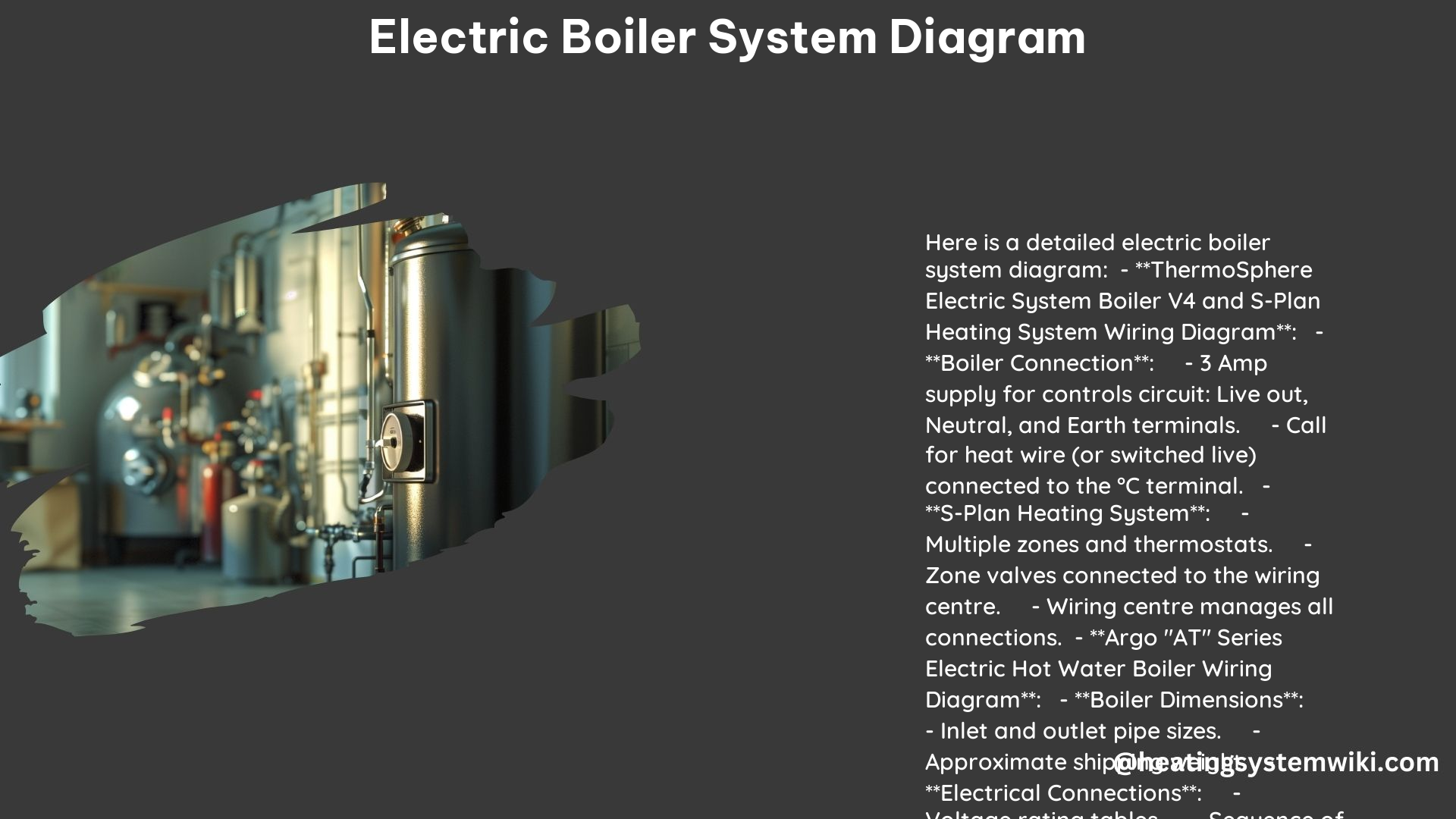An electric boiler system diagram is a crucial tool for understanding the intricate components and connections involved in an electric boiler installation. This comprehensive guide will delve into the key components, wiring requirements, and essential safety features to ensure a safe and efficient electric boiler system.
Key Components to Include in an Electric Boiler System Diagram
-
Electric Boiler: The central component that converts electrical energy into heat for both domestic hot water (DHW) and radiant heat applications. Electric boilers typically range from 3 kW to 36 kW in power output, with higher-end models capable of up to 72 kW.
-
Heating Element: The heating element is responsible for converting electrical energy into thermal energy, which is then transferred to the water within the boiler. These elements are typically made of high-grade stainless steel or copper alloys to withstand the high temperatures and pressures.
-
Thermostat: The thermostat regulates the temperature of the water by controlling the operation of the heating element. Advanced electric boilers may feature multiple thermostats to provide precise temperature control for both DHW and central heating.
-
Pumps: Circulation pumps are essential for distributing the heated water throughout the system, ensuring efficient heat transfer to the desired zones. The pump size and flow rate should be carefully selected based on the system’s heating requirements.
-
Zone Valves: Zone valves are used to control the flow of water to different heating zones, allowing for independent temperature control and energy-efficient operation.
-
Safety Isolation Switch: This switch provides a safe means of electrical isolation, enabling safe maintenance and servicing of the electric boiler system.
-
Circuit Breaker: The circuit breaker protects the electric boiler system from overcurrent, ensuring safe and reliable operation.
-
Wiring Centre: The wiring centre manages all the electrical connections between the thermostats, zone valves, and power supply, simplifying the installation and maintenance process.
Wiring an Electric Boiler for Both DHW and Radiant Heat

-
Dedicated Circuit: It is crucial to ensure that the electric boiler has a dedicated electrical circuit, protected by a suitably rated circuit breaker. This dedicated circuit prevents overloading and ensures the safe operation of the boiler.
-
Cable Sizing: The cables used to power the electric boiler must be sized appropriately to handle the maximum current draw of the boiler. Refer to the boiler’s technical specifications and local electrical codes to determine the correct cable size.
-
Single-Phase or Three-Phase Supply: Electric boilers can be connected to either single-phase (230V) or three-phase (400V) electrical supplies, depending on the power requirements and available infrastructure.
-
Wiring Diagrams: Consult the specific wiring diagrams provided by the boiler manufacturer, such as those from ThermoSphere or Galanshop, to ensure the correct wiring connections and configuration for your electric boiler model.
Ensuring Proper Circuit Sizing for an Electric Boiler
-
Calculate Maximum Load: Determine the maximum current draw of the electric boiler based on its power rating. For example, a 12 kW electric boiler connected to a 230V single-phase supply would have a maximum current draw of approximately 52 amps (12,000 W / 230 V = 52.2 A).
-
Select Suitable Cable: Choose a cable that can safely handle the calculated maximum current draw, with an appropriate safety factor. For the 12 kW example, a 6 mm² or 10 mm² cable would be suitable, depending on the cable length and installation conditions.
-
Install Correctly Rated Switching Equipment: Ensure that the circuit breaker or miniature circuit breaker (MCB) installed in the circuit is rated for the maximum current draw of the electric boiler. In the 12 kW example, a 63A circuit breaker would be appropriate.
Safety Features to Include in an Electric Boiler System Diagram
-
Safety Isolation Switch: The safety isolation switch provides a safe means of electrically isolating the electric boiler for maintenance and servicing, reducing the risk of electric shock.
-
Circuit Breaker: The circuit breaker protects the electric boiler system from overcurrent, preventing potential fire hazards and ensuring the safe operation of the installation.
-
Earthing: Proper earthing of the electric boiler and associated components is essential for safety, as it provides a path for any fault currents to be safely dissipated.
-
Fire Hazard Prevention: Careful consideration of cable sizing and circuit loading is crucial to prevent overloading and potential fire hazards. Adhere to local electrical codes and manufacturer recommendations to ensure the system is installed safely.
Technical Specifications for Electric Boiler System Diagram
-
Voltage Rating: Specify the voltage rating of the electric boiler, which can be either 230V (single-phase) or 400V (three-phase).
-
Power Rating: Indicate the power rating of the electric boiler in kilowatts (kW), which typically ranges from 3 kW to 72 kW for residential and light commercial applications.
-
Cable Size and Type: Clearly specify the size and type of cables used to power the electric boiler, based on the calculated maximum load and local electrical regulations.
-
Safety Certifications: Ensure that the electric boiler and associated components comply with relevant safety standards and certifications, such as CE marking, UL listing, or other regional requirements.
By understanding the key components, wiring requirements, and essential safety features outlined in this comprehensive guide, you can effectively design and install a safe and efficient electric boiler system. Remember to always consult local electrical codes, manufacturer instructions, and seek professional assistance if necessary to ensure the safety and compliance of your electric boiler installation.
References
- ResearchGate. (n.d.). Schematic diagram of the electric boiler retrofitted with an ASHP unit. Retrieved from https://www.researchgate.net/figure/Schematic-diagram-of-the-electric-boiler-retrofitted-with-an-ASHP-unit_fig2_350978004
- ThermoSphere. (2023). Guide to Installing Electric Boilers. Retrieved from https://www.thermosphere.com/blog/guide-to-installing-electric-boilers
- Argo Controls. (2018). “AT” SERIES ELECTRIC HOT WATER BOILERS. Retrieved from https://argocontrols.com/sites/default/files/240009740%20REV%20E%20ARGO%20AT%20ELECTRIC%20BOILER%20IOM.pdf
- Galanshop. (n.d.). Electrical circuit diagrams. Retrieved from https://www.galanshop.eu/wiring-diagram
- ElProCus. (n.d.). Electric Boiler : Working, Types, Differences & Its Applications. Retrieved from https://www.elprocus.com/electric-boiler/
